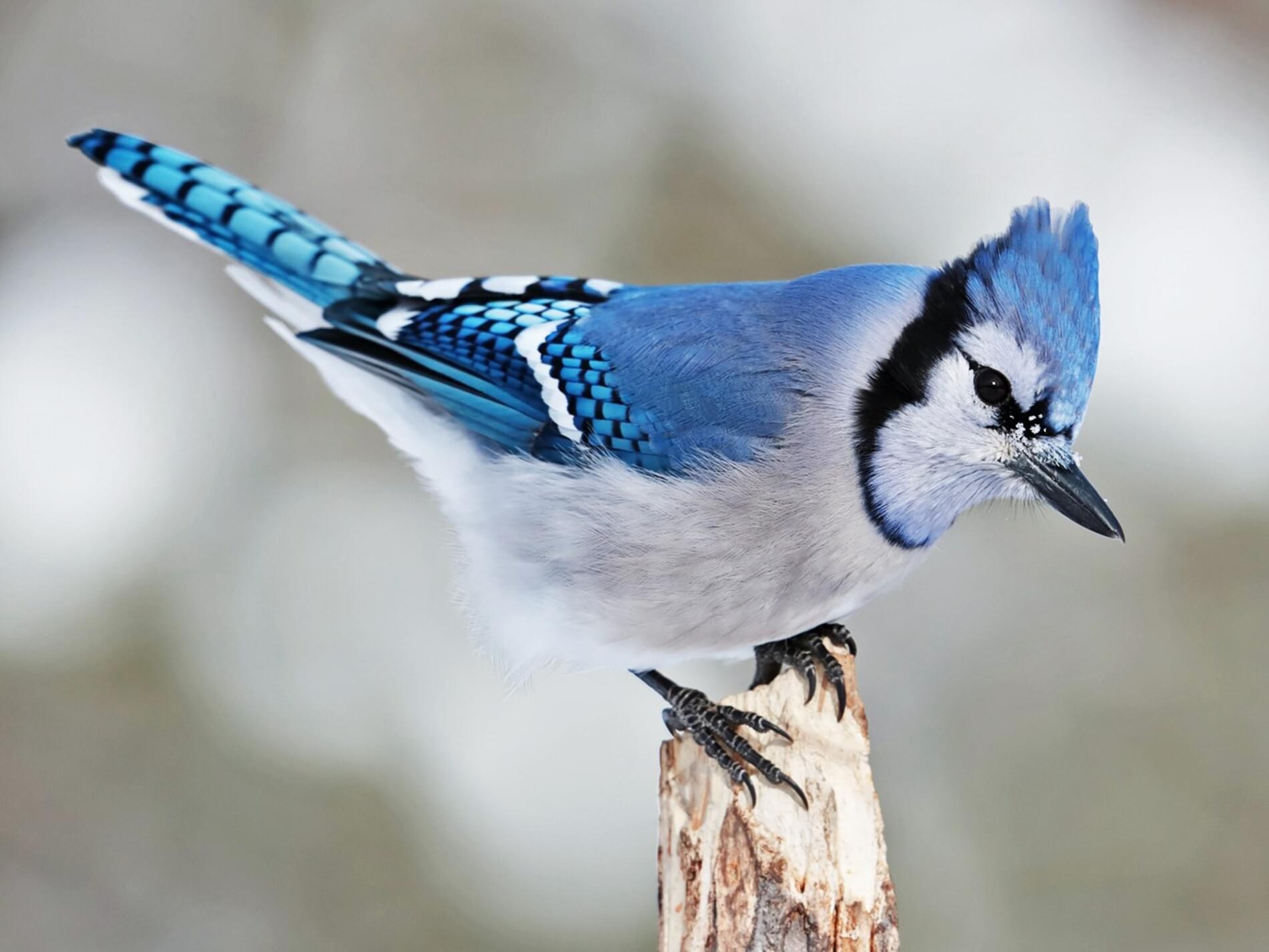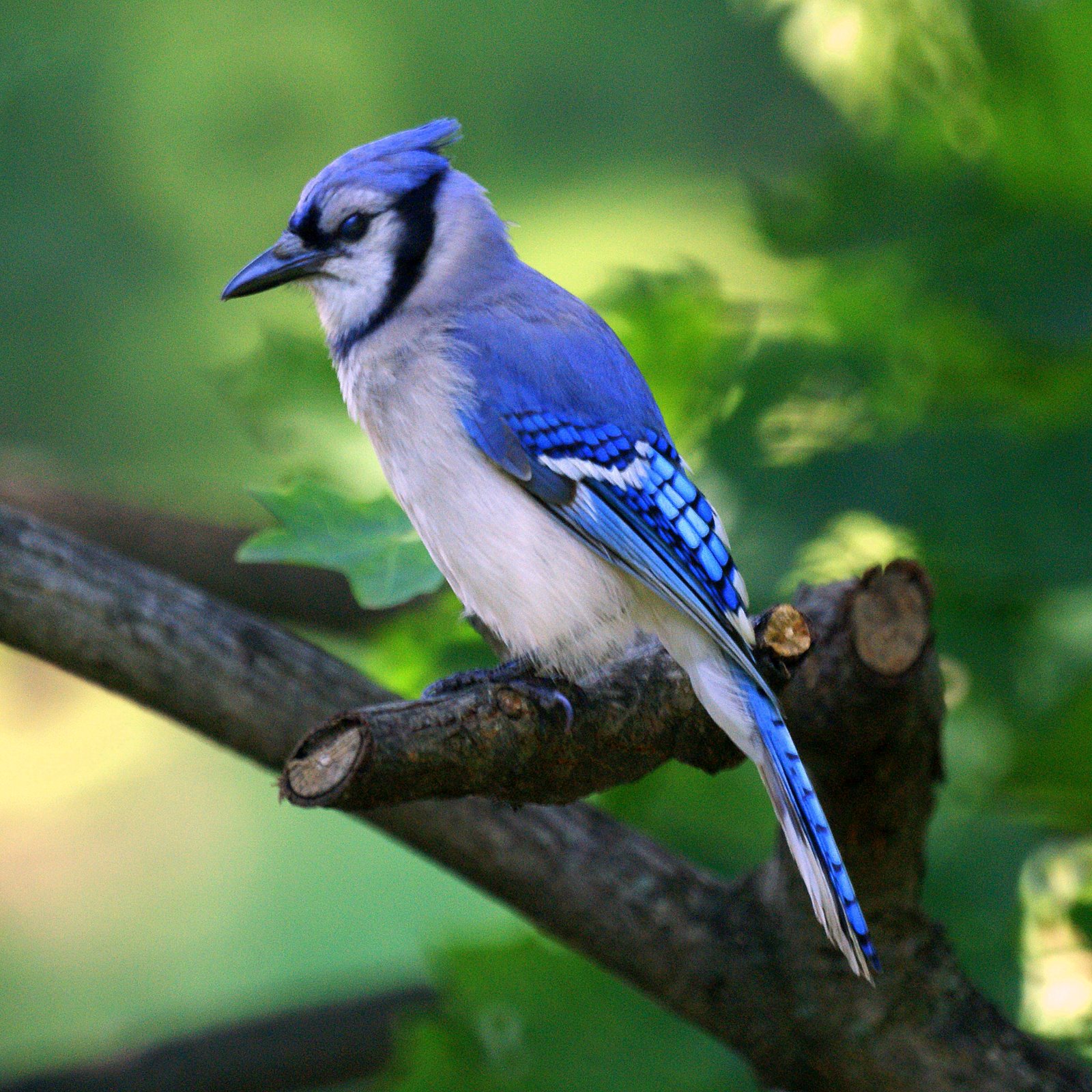Blue Jay Biology and Behavior

The Blue Jay, a common and conspicuous resident of North American woodlands, is a captivating bird known for its intelligence, striking plumage, and boisterous calls. These birds are a fascinating example of avian adaptability and social complexity, thriving in a variety of habitats and displaying intricate communication patterns.
Physical Characteristics, Blue jays
The Blue Jay is a medium-sized songbird, measuring approximately 10-12 inches in length with a wingspan of 15-18 inches. It exhibits a distinctive and striking color pattern, with a bright blue crest, wings, and tail, contrasting with white underparts and a black neck band. The blue jay’s plumage is often described as “electric blue,” with a sheen that appears iridescent in certain lighting conditions. Its wings and tail are marked with black barring, further enhancing its visual appeal. The bill is strong and pointed, adapted for cracking seeds and nuts.
Habitat and Distribution
Blue Jays are adaptable birds, thriving in a variety of habitats, including deciduous forests, mixed woodlands, parks, and suburban areas. They are found throughout eastern and central North America, ranging from southern Canada to Florida and west to the Rocky Mountains. Their ability to adapt to human-modified landscapes has contributed to their success in expanding their range and population size.
Diet and Foraging Habits
Blue Jays are omnivorous, with a diet that includes a wide variety of food sources. Their primary food source is acorns, which they store in caches for later consumption. They also consume a variety of seeds, nuts, fruits, insects, and occasionally small vertebrates. Blue Jays are opportunistic feeders, often scavenging from bird feeders and garbage dumps.
Vocalizations and Communication
Blue Jays are known for their loud and varied calls, which play a vital role in their communication. They possess a repertoire of calls, including a distinctive harsh “jay” call, which serves as an alarm signal. They also produce a variety of other sounds, including whistles, clicks, and rasping noises. Blue Jays are also known for their mimicry abilities, imitating the calls of other birds, as well as sounds made by humans, such as car horns and sirens.
Social Behavior
Blue Jays are highly social birds, living in family groups or flocks outside the breeding season. They are known for their complex social interactions, which involve a range of behaviors, including cooperative foraging, territorial defense, and mobbing predators.
Blue Jays are highly intelligent birds, displaying complex problem-solving abilities and social learning.
Blue Jays are highly territorial during the breeding season, defending their nesting territories against intruders. They often engage in aggressive displays, such as wing-fluttering, bill-pointing, and dive-bombing. However, they also exhibit cooperative behavior, such as helping to raise young or sharing food resources. Their social interactions are complex and involve a combination of competition and cooperation, reflecting the adaptive strategies that have contributed to their success.
Blue Jay Ecology and Conservation: Blue Jays

The Blue Jay, a vibrant and intelligent bird, plays a crucial role in its ecosystem, impacting seed dispersal, forest regeneration, and influencing the dynamics of other species. Understanding the Blue Jay’s ecological contributions is vital for effective conservation efforts, particularly in the face of growing threats to its populations.
Role in Seed Dispersal and Forest Regeneration
The Blue Jay’s diet consists primarily of acorns, nuts, and seeds, which it often caches for later consumption. This caching behavior is a significant factor in seed dispersal, contributing to the regeneration and expansion of forests. By burying seeds in various locations, Blue Jays effectively plant new trees, promoting biodiversity and enhancing forest resilience.
Threats to Blue Jay Populations
Blue Jay populations face a range of threats, including habitat loss, climate change, and predation.
- Habitat loss due to deforestation and urbanization is a major concern, reducing the availability of nesting sites, food sources, and suitable territories.
- Climate change can disrupt breeding cycles, alter food availability, and increase the frequency of extreme weather events, impacting Blue Jay populations.
- Predation by larger birds, mammals, and snakes can also pose a threat to Blue Jay nests and young, particularly during the breeding season.
Effectiveness of Conservation Efforts
Conservation efforts aimed at protecting Blue Jay populations include habitat restoration, protection of nesting sites, and education campaigns to raise awareness about the importance of Blue Jay conservation.
- Habitat restoration projects focus on planting native trees and shrubs, providing suitable nesting and foraging areas for Blue Jays.
- Protection of nesting sites involves safeguarding areas from human disturbance, ensuring the safety of nests and young.
- Education campaigns aim to increase public understanding of the ecological importance of Blue Jays and encourage responsible actions to support their conservation.
Promoting Blue Jay Conservation in Your Local Area
To promote Blue Jay conservation in your local area, consider implementing the following strategies:
- Plant native trees and shrubs in your yard or community gardens, providing food and shelter for Blue Jays.
- Avoid using pesticides and herbicides that can harm Blue Jays and other wildlife.
- Educate yourself and others about the importance of Blue Jay conservation and the threats they face.
- Support organizations working to protect Blue Jay populations and their habitats.
Blue Jay in Human Culture
The Blue Jay, with its striking plumage and boisterous calls, has captivated human imagination for centuries. Its presence in various cultures and traditions reflects a complex relationship, often intertwined with symbolism and folklore. This section explores the cultural significance of the Blue Jay, delving into its representation in literature, art, and music, and its impact on human perceptions of nature and wildlife.
Symbolism and Cultural Significance
The Blue Jay holds diverse symbolic meanings across different cultures. In some Native American tribes, it is seen as a messenger, representing communication and wisdom. The Iroquois believed the Blue Jay was a trickster figure, embodying both mischief and intelligence. In European folklore, the Blue Jay was often associated with good luck, while in other cultures, it symbolized change and transformation. The vibrant blue color of its plumage has been linked to themes of freedom, creativity, and spirituality.
Blue Jay in Literature, Art, and Music
The Blue Jay’s distinctive appearance and behavior have inspired countless artists, writers, and musicians. In literature, the Blue Jay often appears as a symbol of nature’s beauty and wildness. Henry David Thoreau, for example, described the Blue Jay as a “splendid bird” in his writings. In art, the Blue Jay has been depicted in various mediums, from paintings to sculptures. The bird’s striking colors and intricate patterns make it a popular subject for nature-themed art. In music, the Blue Jay’s calls have been incorporated into compositions, capturing its lively and energetic nature.
Impact on Human Perceptions of Nature
The Blue Jay’s presence in human culture has had a significant impact on our perceptions of nature and wildlife. Its bold and assertive nature has made it a symbol of resilience and adaptability. The Blue Jay’s ability to thrive in diverse habitats, from forests to suburban backyards, reflects its capacity to adjust to changing environments. Its loud calls and territorial behavior can sometimes be seen as a nuisance, but they also highlight the importance of respecting wildlife and understanding its role in the ecosystem.
Blue Jay in Popular Culture
The Blue Jay has also made its mark in popular culture, appearing in various forms of entertainment. Here is a table showcasing some notable examples:
| Medium | Example | Description |
|---|---|---|
| Film | “The Fox and the Hound” | The Blue Jay, named “Dinky”, is a mischievous and playful character who befriends the young fox, Tod. |
| Television | “The Simpsons” | The Blue Jay is a recurring character in the animated sitcom, often seen perched on a tree or flying overhead. |
| Video Games | “Animal Crossing” | The Blue Jay is a common resident in the “Animal Crossing” series, known for its cheerful personality and playful antics. |
Blue jays, with their bold plumage and loud calls, are a sight to behold. Their vibrant blue feathers remind me of the classic New York Yankees uniforms, a team with a legacy of success, like the Yankees themselves. Both the birds and the team represent strength and a certain kind of swagger, a vibe that’s hard to ignore.
Just like the blue jays, the Yankees always seem to be around, reminding us of their dominance and leaving a lasting impression.
You know those birds with the super loud calls and the bright blue feathers? Yeah, those are blue jays! They’re pretty common around here, especially in the parks. They’re actually super smart, did you know? You can learn more about these feathery friends by checking out this article.
It’s got some cool facts about blue jays, like how they can mimic other bird sounds!

